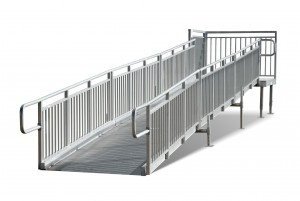Aluminum ADA ramps from REDD Team are an affordable, efficient way to ensure you’re compliant with not only ADA mandates, but all other accessibility requirements as well. Our ramps make it easy for people suffering from physical challenges to enter and exit buildings safely and comfortably. If you operate any type of public building, you know how critically important it is to meet all accessibility mandates. We can help you do just that.
Why is Accessibility So Important?
 The U.S. Congress passed the Americans with Disabilities Act into law in 1991. Since then, public facilities across the country have taken steps to provide access for people dealing with disabilities. Aluminum ramps are a huge component of maintaining ADA compliance. They are perfect for people with mobility issues, because they provide convenient access to areas that may be elevated, or otherwise difficult to reach.
The U.S. Congress passed the Americans with Disabilities Act into law in 1991. Since then, public facilities across the country have taken steps to provide access for people dealing with disabilities. Aluminum ramps are a huge component of maintaining ADA compliance. They are perfect for people with mobility issues, because they provide convenient access to areas that may be elevated, or otherwise difficult to reach.
Whether someone is using a wheelchair, a cane, crutches or any other type of mobility aid, access is vital. If you fail to provide it, you could be subject to huge fines or potential legal action. Our lightweight, durable ramps will not only help you avoid those issues, they will also help increase safety. We’ve provided ramps for a wide variety of public buildings, including apartments, schools, retail stores, churches and many, many others.
We’re the undisputed leader in the manufacture of accessibility components, including not only ramps, but also stairs, platforms and more. Our products are compliant with the ADA, and also meet the stringent requirements of other codes as well. These include the following.
- Life Safety 101
- IBC
- BOCA
- UBC
- SBC
- SREF
Making Sure Your Ramps are ADA Compliant
There are, as you would probably imagine, a lot of requirements that go into making sure your ramps are compliant with the ADA. Below you’ll find just a few of them. Make sure you talk to your city’s building inspector to learn more.
- The ramp must include an unobstructed, level area at both the top and the bottom. These flat areas must be at least 5 feet by 5 feet.
- All ramps have to be at least three feet wide. However, certain states require wider ramps than the ADA requires. For example, codes in California and Massachusetts both mandate that ramps must be four feet wide.
- In order to be ADA compliant, a ramp can’t have a slope ratio of more than 1:12. This basically means that for every inch of rise, you must have a foot of ramp. If, for instance, the rise of the ramp will be 30 inches, then the ramp must be at least 30 feet long.
- If your ramp is to be more than 30 feet, it must include an intermediate platform.
- All ramps must include protection at the edges in order to eliminate the risk for an accidental slip.
- If your ramp has a rise that’s higher than six inches, or it projects more than 72 inches in a horizontal direction, it must also include handrails on both sides. These handrails must be no smaller than between 34-38 inches high.
- The surface of the ramp has to resist water accumulation, and must also be slip resistant.
All of our ramps meet these and many other requirements. If you would like more information on REDD Team aluminum ADA ramps, please call (800) 648-3696 or contact us online.

